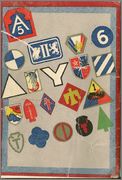Continuing...
Later in 1944, the Brazilian Forces joined the Allies in Europe to help the actions in Italy, after a gross part of the more experienced troops left for Anzio, South of France and even Normandy. With very few time for proper training, the Brazilian troops compensated with great character and capacity of adaptation to war conditions in a very tough terrain and climate, being well honored by all the staff of the Allied High Command during their participation in the Italian Campaign. Many Brazilian soldiers were condecorated with the highest medals of the American Forces. This has been the finest hour for the Brazilian Expeditionary Force (FEB).
In the first days of July, 1944, the first Echelon of the Brazilian Expeditionary Force FEB – left to Europe, aboard the American ship General Mann, in a total of 5.081 men. Originally, the ship should be going to Argel, where the troops would get preliminary training before landing in Italian soil. However, the convoy headed straight to Naples, where the troops disembarked and waited to join US Task Force 45. Later, on the 22nd July, two more ships, Gen Mann and Gen Meigs, left to Europe, with the Second and Third Echelons, with 10.369 men total. The last two Echelons, Fourth, with more 4.722 men and Fifth,with 5.128 men, left Brazil on the last days of November and first days of February ’45, totaling 25.300 men.
The troops were moved to Tarquinia, 350 Km North of Naples, where the US 5th Army, commanded by the famous Gen Mark Clark, was based. The Brazilian troops were incorporated to the 4th Army Core, commanded by Gen Crittenberger. On the 19th August, Churchill himself visited the 5th Army in Cecina, where he was told that Brazilian troops were part of the Guard of Honor. He directed some of his speech to the Brazilian troops that now joined the war effort in Italy.
The Brazilian troops were filling the gap left by several divisions of the 5th US Army and French Expeditionary Force that went to the invasion in the South of France. This straight action with the fresh Brazilian troops was a necessity, due to the great operation at Anzio, to where so many American and British troops were issued. The overall command of Brazilian troops was made from the High Command of the 15th Allied Army Group, headed by Gen Mark Clark and Gen Crittenberger (5th Army and 4th Army Core, USA), Field marshal Alexander (8th Royal Army, England) together with the high staff of the Brazilian Army, Gen Euríco Dutra, Gen Mascarenhas de Moraes, Gen Zenóbio da Costa and Gen Cordeiro de Farias (commanders of several Infantry and Artillery Divisions among the whole of the Brazilian Expeditionary Force).
A very interesting fact is that on November 16th, FEB occupied Massarosa. Two days later, Camaiore and other small towns and cities on the way North. During this period, the Brazilians G.I.s, or “pracinhas”, created the FEB symbol, consisting of a badge with a snake over National colors (Green and Yellow), with a smoking pipe in mouth. This was a big irony to answer a group of the society opposing Brazil entering the conflict, who used to say that it was easier to see a snake smoking than to see Brazilian troops sent to fight the war…
 To be Continue....
To be Continue....
















